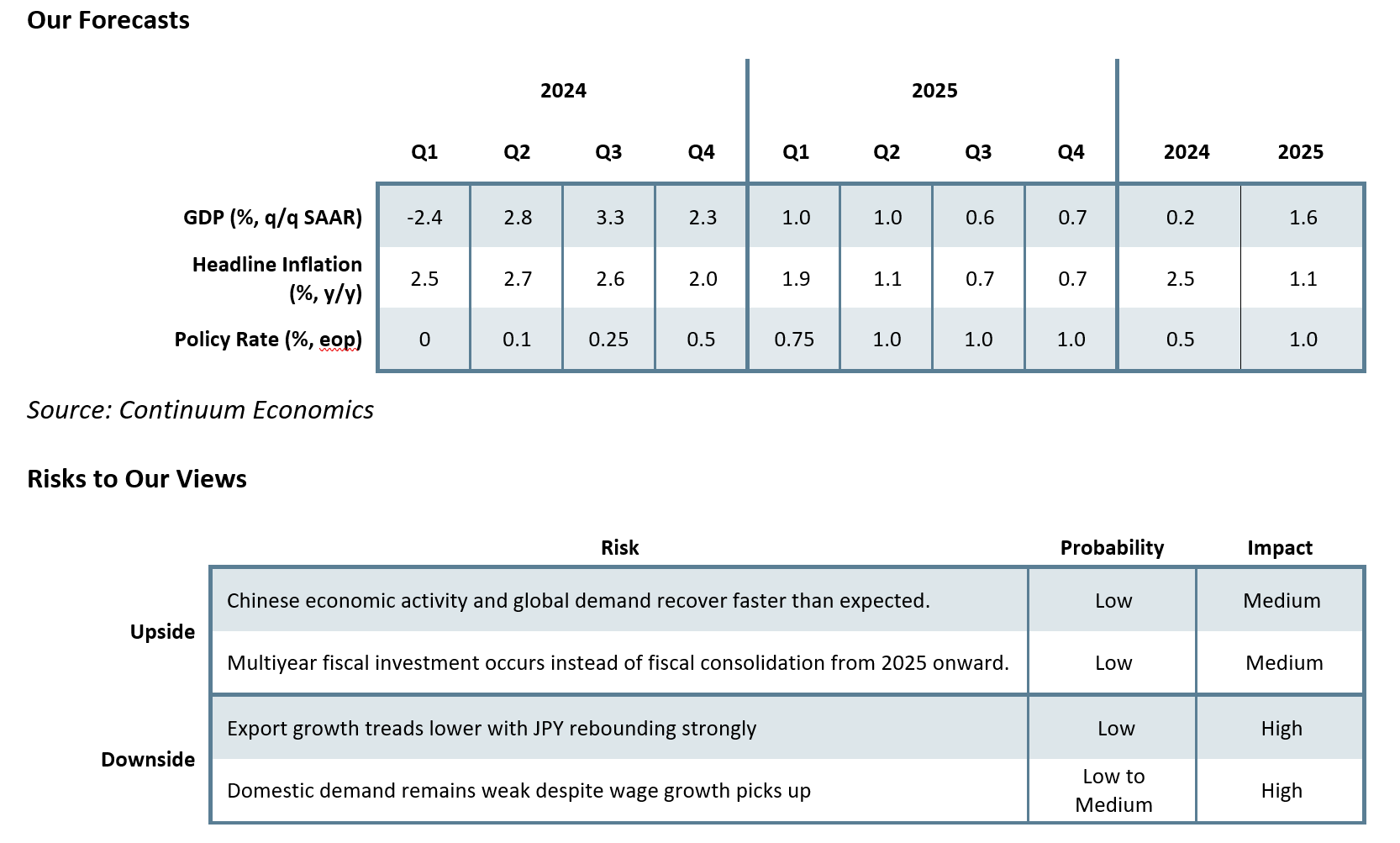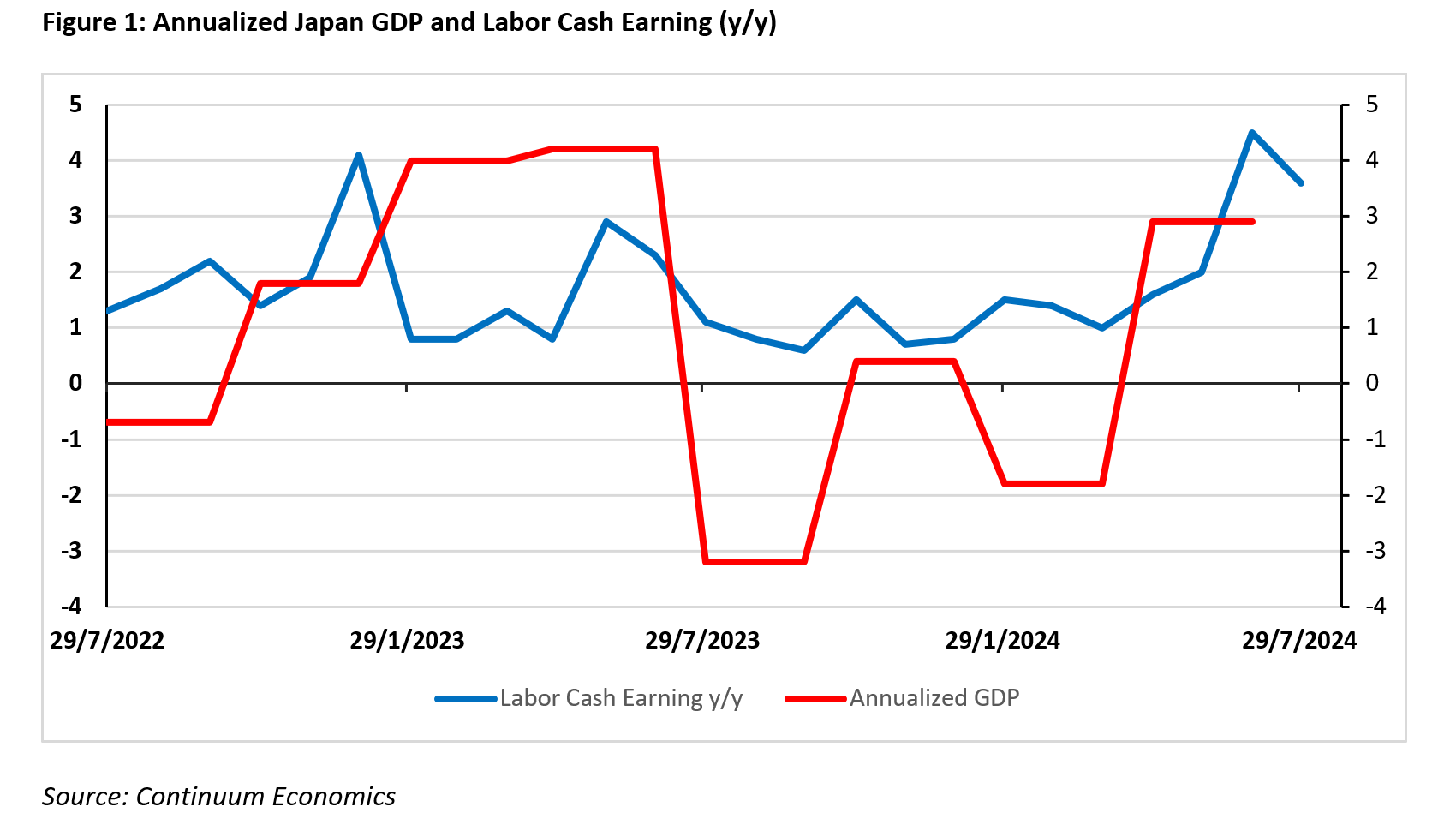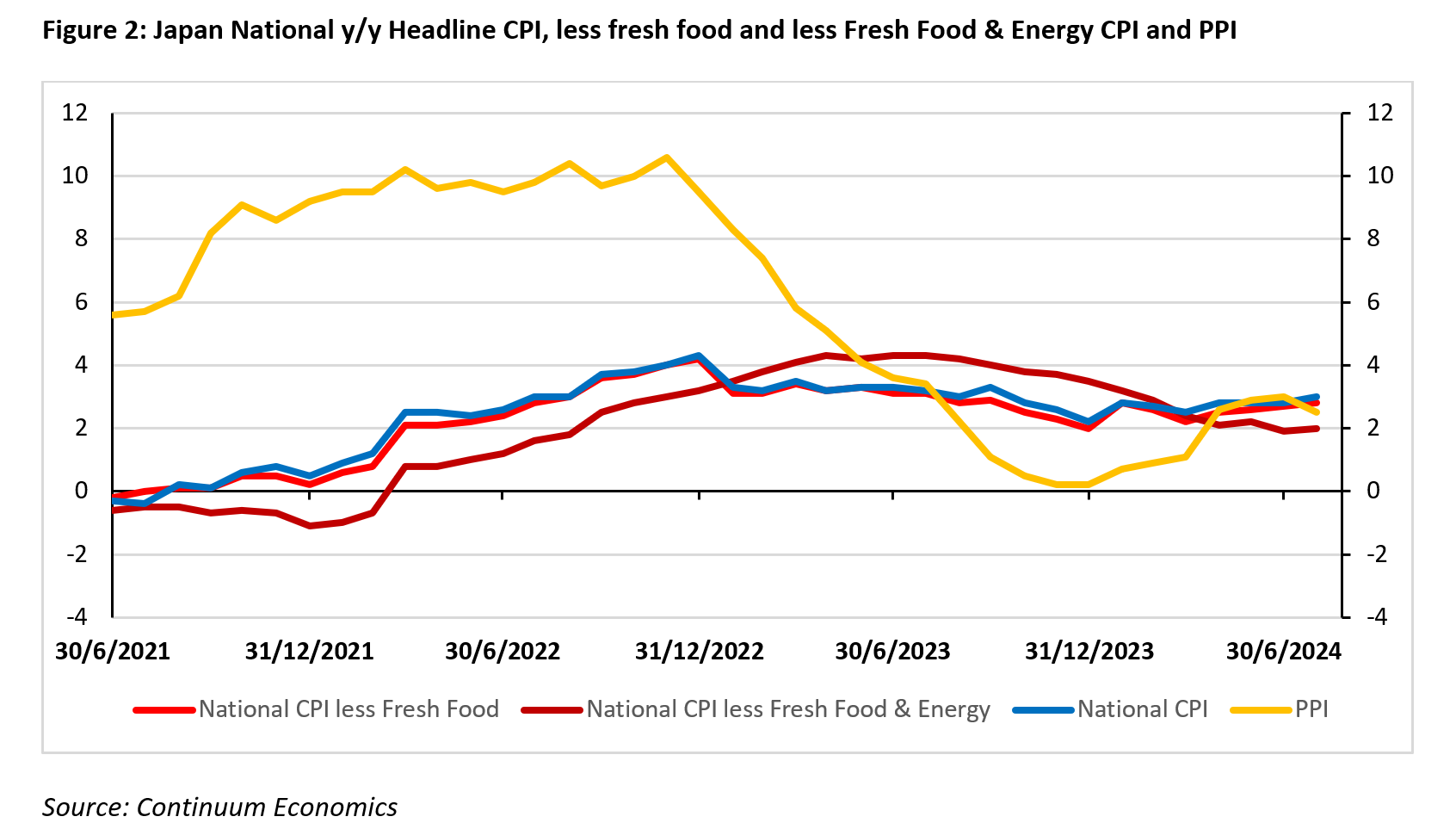Japan Outlook: A Hawkish Take
· GDP growth for 2024 has been revised lower to +0.2% after the consumption contraction in Q1 2024 and the subsequent sluggish recovery in Q2. Private consumption is expected to pick up along improving real wages but its magnitude will be limited by the unwillingness to consume at high prices. Modest consumption growth is expected in 2025 with company profit margin unlikely to support another round of wage growth like 2024. The trade balance in 2024 would be solid as exports continue to benefit from the lagged soft JPY before returning to neutral for GDP in 2025 - we forecast +1.6% GDP in 2025. Government spending steadies throughout 2024/25 as the Japanese government’s fiscal room is limited.
· We are forecasting the BoJ to tighten the key policy rate by 25bps in October 2024 with another two 25bps hikes in the first two quarters of 2025 and bring the neutral rate to 1%. The BoJ has taken a hawkish tilt in their July meeting in sight of inflation picking up by raising interest rate and began to reduce JGB purchase, halving in a two years horizon.
· However, trend inflation is likely to tread below BoJ expectation in 2025 from the slower pace of wage growth and change in Japanese consumer behavior. Despite Japanese business have begun to exert changes to price setting behavior, the low PPI and customers’ reluctance will restrain price increase and suggests less feed through to CPI than BOJ forecast from a trend inflation perspective. Yet, the boost from positive real wage will likely induce a wave of consumption in 2024. Even so, this should be enough to end BOJ rate hikes.
Forecast changes: We revised 2024 GDP lower to +0.2% from +0.4% as private consumption contracted in Q1 2024 but have yet to show a significant rebound when real wage turned positive. 2025 GDP also revised higher to 1.6% -- though this pace will not be sustained in 2026 and is a rebound for 2024. 2024 CPI is revised slightly higher to +2.5% from +2.4% to adjust for the short-term squeeze from higher wages.

Macroeconomic and Policy Dynamics
The BoJ has taken a hawkish policy stance in the July meeting by hiking interest rate to 0.25% and announced a bond purchase reduction plan (halving the pace by around 3 trillion JPY in two years) as Japanese headline inflation edge higher (July 2.8% y/y and August 3%). Labor Cash earnings rose past 2% (June 4.5% y/y and July 3.6%) and is expected to be above 2% for the rest of 2024. Wage growth for small to medium firms will likely be lower than large firms but still sufficient to bring real wages to positive. BoJ believe such a trajectory would translate into higher trend inflation, along with the change of business price setting behavior.
After the contraction of private consumption in Q1 2024, there are signs of an economic rebound along wage growth, yet the underlying momentum of household spending has been lacking (July overall household spending 0.1% y/y). The recovery in consumption seems to be a relief of pent up demand on rising wages, instead of a drastic change in spending behavior. Thus, our 2024 inflation forecast are revised only marginally higher to +2.5% from +2.4% to reflect such behavior brought by improving real wage in the face of a reluctant consumer.

Our forecast for 2024 GDP is revised lower to +0.2% to reflect the Q1 private consumption contraction and likely gradual recovery for the rest of 2024. Economic growth will be normalized from more balanced wage/inflation dynamics and thus 2025 GDP’s forecast is +1.6%. Private consumption is expected to rebound in H2 2024 with pent up demand relieved by positive real wages, but growth will return to being modest in 2025 from the reluctance to spend at high price. Headline labor cash earning has grown at a decent pace above 2% for the past three months, contributing to stronger trend inflation in BoJ’s eyes. However, the strong gains in wage is unlikely to be repeated in 2025 as higher labor cost and modest consumption will further squeeze profit margin where small and medium business are already struggling. Government spending will be steady given the limitation in fiscal space and we are not forecasting another round of stimulus.
The Japan trade balance should still benefit from the lagged impact of soft JPY and be a major contributor towards Japan economic growth in 2024, before return to a more balanced force in 2025. Japanese Yr/Yr export & import continues to grow by 1.5% and 1.7% (in real terms) in Q2 2024 and is expected to be steadily growing for the rest of 2024 – exports are bigger than imports producing the net export benefit. Japanese exports to China is the biggest growth factor in trade. The Chinese government has recently released the ban on Japanese seafood import, seems to open doors for improving trade relationship and may provide a minor benefit for Japanese trade figures. As the BoJ took a hawkish turn and the Fed begun its easing cycle, it looks like the JPY will inevitably strengthen significantly in a medium run and make Japanese goods less cheap and see a more neutral net export contribution in 2025.

Meanwhile, BoJ has revised their inflation forecast in July for y/y CPI less fresh food from +2.8% to +2.5% for 2024 and from +1.9% to +2.1% for 2025 but kept y/y CPI less fresh food & energy at +1.9% for both 2024 and 2025. BoJ had privately viewed the +2% inflation target a long shot but now sees trend inflation reaching such target because business in Japan are exerting a change in price/wage setting behavior in face of higher input prices in the past two years (Figure 2). Still, the BoJ seems to be too optimistic at the pace and magnitude of change in business price/wage setting behavior and looks likely to underestimate the reluctance of consumer to accept higher inflation.
Fresh food and energy, once the biggest inflationary factor, has moderated further (with energy prices contracted by 0.4% y/y in August 2024) and is not expected to resume their post COVID era inflationary impulse. However, the National y/y CPI has risen to 3% in August 2024 (led by service) and is forecast to remain elevated in Q3 2024 before gradually descending. In 2024, headline CPI is forecast to be +2.5%, driven by the strong wage hike that pushes prices higher in the short run yet limited by both consumption and price setting behavior. By 2025, we project headline inflation would revert to the traditional Japanese pace of +1.1% as the pace of wage growth cannot be sustained and BoJ cumulative tightening anchors inflation expectations.
Policy Outlook
The BoJ tilted towards a hawkish stance and brought short term interest rate to +0.25% in July in face of higher anticipated trend inflation from the change of Japanese business price & wage setting behavior. Bond purchase will also be halved (around 3 trillion JPY) over the coming two years starting from July 2024. The BoJ would like the market to decide long term interest rates and they are only favoring gradual changes in yields with commitment to intervene on any major spike. It is also worth noting that Ueda has hinted that the BOJ could reduce ETF holdings in the future and QT could start with Japanese equities.
With early signs of price & wage setting behavior being inflationary, we believe the BoJ will hike by another 0.25% to bring short term interest rate to +0.5% in October and hike twice in Q1/2 2025 to bring the policy rate to 1%. In the August 2024 statement, the BoJ stated that current development in line with their forecast is enough to deliver further normalization. Multiple BoJ policy board members and governor Ueda have also built the rhetoric of more tightening if forecast aligns in the past months, also floating the idea of the neutral rate being 1%. It seems to suggest another round of tightening is imminent.
However, we are cautious towards such hawkish policy in H2 2025. While price & wage setting behavior is changing, it takes time to change traditional habits and we believe consumption growth would be more gradual than BoJ expect (overall household spending and retail trade did not follow the boom in labor cash earning). After the relief of pent up demand from wage boost in H2 2024, the reluctance to continuously consuming at a higher price is likely to squeeze corporate margin growth in 2025, meaning that companies would turn to less wage increases in 2025 and subsequently lower CPI. The hawkish policy may drive trend inflation to be lower than BoJ’s target of 2%. The failed normalization attempts in 2000 and 2006 show that the BOJ can go too far and then end up reducing the policy rate.